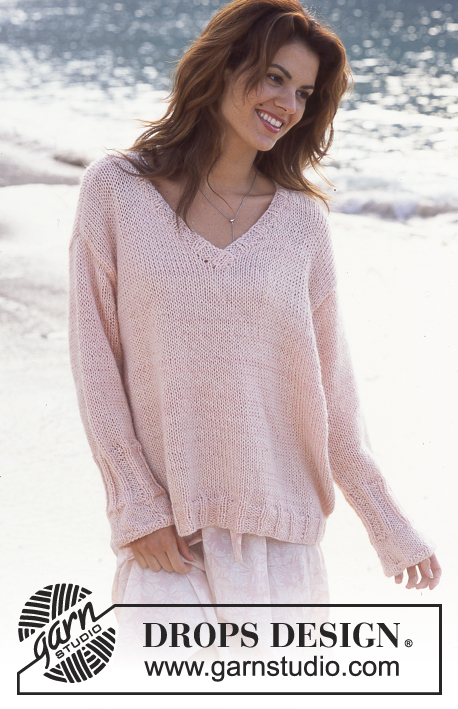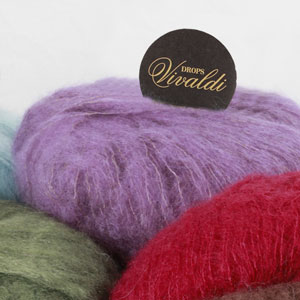Comments / Questions (17)
![]() Vibeke Dahl wrote:
Vibeke Dahl wrote:
Hvor mange masker på rundpind nr 6 med estrafine merino. Oversize str M og kun en tråd?
14.01.2025 - 08:20DROPS Design answered:
Hej Vibeke, det bliver meget løst til den her opskrift og strikker du DROPS Merino Extra Fine så løst, så vil den vokse i længden.
14.01.2025 - 11:56
![]() Maria wrote:
Maria wrote:
Lo q no me queda claro es en el inicio del jersey si son un punto al derecho y otro al revés porque menparece más ancho, no serán 2 puntos al derecho y 2 al revés?
23.09.2024 - 15:46DROPS Design answered:
Hola María, el elástico se explica en la sección RESORTE, justo encima del inicio de la labor. Dos derechos, 4 reveses por el lado derecho y 2 reveses 4 derechos por el lado revés (es decir, por el lado revés trabajas derecho sobre derecho y revés sobre revés). No olvides el punto en punto musgo a cada lado.
29.09.2024 - 18:57
![]() Else Barbro Wattenberg Tveitan wrote:
Else Barbro Wattenberg Tveitan wrote:
Hei. Er det en grunn til at genseren skal strikkes i for og bakstykket, og ikke i et stykke, altså hel bol? På forhånd tusen takk for svar.
18.03.2024 - 10:58DROPS Design answered:
Hej Else, du må meget gerne strikke den rundt på rundpind :)
19.03.2024 - 10:58
![]() Cryns wrote:
Cryns wrote:
Puis je faire ce modèle avec laine drops AIR et combien de pelotes dans ce cas pour la taille L merci
26.12.2020 - 16:32DROPS Design answered:
Bonjour Mme Cyns, ce modèle se tricote avec 1 fil du groupe B (= Muskat) et 1 fil du groupe C (= Vivaldi, que l'on peut remplacer par 2 fils Kid-Silk ou 1 fil Brushed Alpaca Silk) - Vous pourrez utiliser Air - exemples de modèles avec 14 m = 10 cm - ou d'autres alternatives au choix, en fonction de la texture souhaitée, pensez à toujours bien faire votre échantillon pour vérifier autant la tension que la texture. Voir aussi ici. Bon tricot!
04.01.2021 - 08:47
![]() Manon Hendry wrote:
Manon Hendry wrote:
I cannot find any of the wool recommended wool here. What brand and kind of wool can I substitute? Thank you
10.03.2020 - 20:46DROPS Design answered:
Dear Manon, firstly, under the materials you have the yarn converter, where you can see the recommended yarns to substitute. Also, you can use the yarn groups of the yarns in the pattern for reference when searching for other yarns, in this case it's yarn group B and C. Happy knitting!
10.03.2020 - 23:34
![]() Laetitia wrote:
Laetitia wrote:
Bonjour, puis je faire ce modèle avec des aiguilles droites ? Merci
20.11.2019 - 08:44DROPS Design answered:
Bonjour Laetitia, tout à fait, ce modèle se tricote en différentes parties assemblées entre elles à la fin; en allers et retours sur aiguille circulaire pour avoir plus de place pour toutes les mailles. Vous trouverez ici plus d'infos générales sur les ouvrages sur aiguilles circulaires. Bon tricot!
20.11.2019 - 09:47
![]() Manon Tessier wrote:
Manon Tessier wrote:
Bonjour , puis-je faire ce modèle avec de la laine musckat seulement et si oui dois-je en commander plus et combien . Merci
21.08.2018 - 03:32DROPS Design answered:
Bonjour Mme Tessier, vous n'auriez pas le bon résultat, car on tricote ici les 2 qualités ensemble. Vivaldi n'est plus disponible, mais vous pouvez la remplacer par Brushed Alpaca Silk. Vous trouverez ici des infos complémentaires sur les alternatives. Bon tricot!
03.09.2018 - 15:04
![]() Manon Tessier wrote:
Manon Tessier wrote:
Bonjour , puis-je faire ce modèle avec la laine musckat seulement et dois-je prendre plus de laine musckat pour le faire . Merci
21.08.2018 - 03:30
![]() Wille wrote:
Wille wrote:
Ik wil even aangeven dat ik voor de trui, maat X, 100 gram meer Muskat nodig had dan aangegeven staat. Ik brei normaal, denk ik. Misschien hebben anderen hier iets aan.
13.03.2018 - 18:07
![]() Wille wrote:
Wille wrote:
Deze trui wordt gebreid met 1 draad Muskat en 1 draad Vivaldi. Als ik wil breien met Alaska, een enkele draad dus, heb ik dan dezelfde hoeveel heid nodig als voor de Muskat, dus 350-400-450-500 gr?
16.02.2018 - 17:25DROPS Design answered:
Hallo Wille, Als je deze trui met 1 draad Alaska breit, kom je op een andere stekenverhouding uit, waardoor je meer bollen nodig zult hebben, tenzij je bewust de stekenverhouding zo houd als in het patroon (dus met te grote naalden breit). Waarschijnlijk heb je dus meer bollen nodig. Het handigst is om even vergelijkbare patronen te bekijken die alleen met Alaska gemaakt zijn en op basis daarvan een schatting te maken. Vraag je verkooppunt of je de bollen die je overhoudt weer in kan leveren.
18.02.2018 - 14:51
Pink Sands |
|
|
|
|
Knitted oversized pullover in DROPS Muskat and Vivaldi or Brushed Alpaca Silk
DROPS 77-25 |
|
|
Gauge: 14 sts x 19 rows with 1 strand Muskat + 1 strand Vivaldi or 1 strand Brushed Alpaca Silk = 10 x 10 cm/ 4" x 4" on larger needles in stockinette st. Rib: Row 1: * K 2, P 4 *, repeat from * - *. Row 2: * P 2, K 4 *, repeat from * - *. Garter st, when knitting flat: Knit all sts, all rows. ______________________________________________ Front: Cast on 86-92-98-104-110 sts on smaller needles with 1 strand Muskat + 1 strand Vivaldi or 1 strand Brushed Alpaca Silk. Knit rib for 5 cm, keeping 1 st at each edge in garter st. Change to larger needles and stockinette st, decreasing 2-2-4-4-4 sts evenly distributed on the 1st row = 84-90-94-100-106 sts. When the piece measures 39-40-41-42-43 cm bind off 7-9-10-12-14 sts at each side for armhole = 70-72-74-76-78 sts. When the piece measures 40-42-44-46-48 cm shape V-neck. Divide the piece at center front and put half the sts on a st holder = 35-36-37-38-39 sts. Then dec 1 st at the neck edge every other row 12-12-13-13-13 times = 23-24-24-25-26 sts remain on shoulder. Bind off when the piece measures 58-60-62-64-66 cm. Put sts back on needles and knit the second side the same. Back: Cast on and knit the same as the front. Bind off for armholes as on front. When the piece measures 56-58-60-62-64 cm bind off the center 22-22-24-24-24 sts for the neck. On the next row dec 1 st at each neck edge = 23-24-24-25-26 sts remain on each shoulder. Bind off when the piece measures 58-60-62-64-66 cm. Sleeve: Cast on 38-38-38-44-44 sts on smaller needles with 1 strand Muskat + 1 strand Vivaldi or 1 strand Brushed Alpaca Silk. Knit 4 rows rib, keeping 1 st at each edge in garter st. Change to larger needles and stockinette st. When the piece measures 7 cm, change back to smaller needles and knit rib, keeping 1 st at each edge in garter st. When the piece measures 16 cm change back to larger needles and knit stockinette st to finished measurements. At the same time when the piece measures 17 cm inc 1 st at each side every 4-3-2.5-3-2.5 cm a total of 7-9-10-8-9 times = 52-56-58-60-62 sts. When sleeve measures 42-42-41-40-39 cm put a marker at each side (to mark where sleeves will be sewn into armhole). Continue until the piece measures 47-48-48-48-48 cm, then bind off 5 sts at each side every other row 2 times = 32-36-38-40-42 sts. The piece measures approx. 49-50-50-50-50 cm, bind off the remaining sts. Assembly: Sew shoulder seams. Neckband: Pick up 88 or 94 sts (divisible by 6 + 4) around the neck on smaller short circular needles with 1 strand Muskat + 1 strand Vivaldi or 1 strand Brushed Alpaca Silk - start at center front. Knit rib back and forth from center front keeping 1 st in garter st and begin and end rib with K 2 (seen from the right side). When the rib measures 2.5 cm bind off all sts in rib. Lay right side of neckband over left at center front and stitch in place. Sew side seams using edge sts as seam allowance.Sew sleeves up to the markers and sew in sleeves. |
|

|
|
Have you finished this pattern?Tag your pictures with #dropspattern or submit them to the #dropsfan gallery. Do you need help with this pattern?You'll find 20 tutorial videos, a Comments/Questions area and more by visiting the pattern on garnstudio.com. © 1982-2025 DROPS Design A/S. We reserve all rights. This document, including all its sub-sections, has copyrights. Read more about what you can do with our patterns at the bottom of each pattern on our site. |

























































Post a comment to pattern DROPS 77-25
We would love to hear what you have to say about this pattern!
If you want to leave a question, please make sure you select the correct category in the form below, to speed up the answering process. Required fields are marked *.